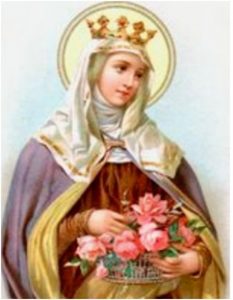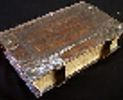
Princess
Elizabeth, the daughter of Andrew II of Hungary, was brought to the court of the rulers of Thuringia in central Germany, to be betrothed to Louis IV, Landgrave of Thuringia, (also known as Ludwig IV), a future union which would reinforce political alliances between the families, she was age 4 and he was age 10. Although many treated her harshly, Louis was very good to her. She was age 14-15 when they finally married, it proved to be a love match. They had 3 children.
Elizabeth influenced by the Franciscans, who had recently reached Germany, enjoyed helping the poor, and Ludwig gave her all she needed to carry out this ministry. She spent large sums on charitable work, funding hospitals and providing for orphans. After 7 years of very happy life, Ludwig died suddenly of the plague while journeying to the crusades. Elizabeth was inconsolable.
Elizabeth then became a Franciscan tertiary, but came under the authority of a harsh priest, Konrad von Marburg, who had been a member of the Inquisition. He treated her with great severity, and under a discipline of fasting, penances and vigils her health suffered. Konrad's treatment of Elizabeth was extremely harsh, demanding standards of behavior which were almost impossible to meet. Among the punishments he is alleged to have ordered were physical beatings; he also ordered her to send away her 3 children. Her brother-in-law, who disapproved of her extravagant generosity, had been made regent for her son, the heir, and it was rumoured for many years that he turned Elizabeth and her 2 daughters out of the castle with, tradition says, a baby at her breast. But she may have left voluntarily, sending away her children in obedience to her confessor Konrad of Marburg. She used her dowry to build a hospital for the poor and sick in Marburg and spent the last 4 years of her life in caring for the patients there. She continued to do this with charm and good humour despite the cruel directives of her confessor, and she refused an invitation to return to Hungary. She was only 24 years old when she died.
Elizabeth was buried at Marburg, and the poor people whom she had helped came to mourn. Her contemporaries were so moved by the story, that she was canonised only 4 years after she died. A year later her body was taken from the humble grave and placed in a rich tomb in a church which was built in her memory. Konrad von Marburg was attacked and killed on the road by several knights, his name became a byword for sadism and the dark side of Catholicism.
BORN: 7 July 1207,
Presburg, Hungary
DIED: 17 November 1231, Marburg, Germany.
 Welcome
Welcome Calendar
Calendar Today's Word
Today's Word Lauds
Lauds Terce
Terce Sext
Sext None
None Vespers
Vespers Compline
Compline Matins
Matins